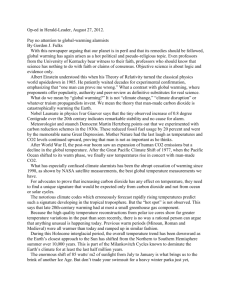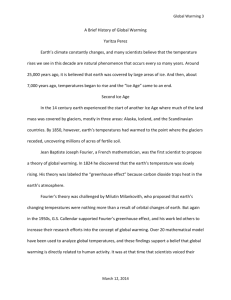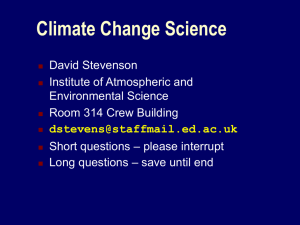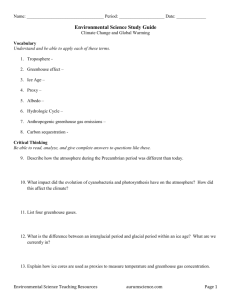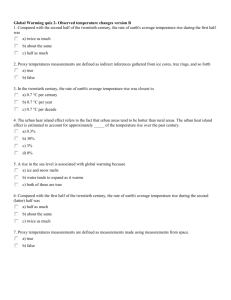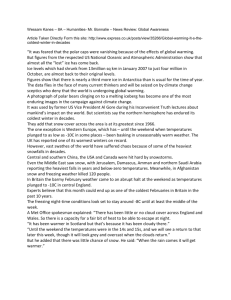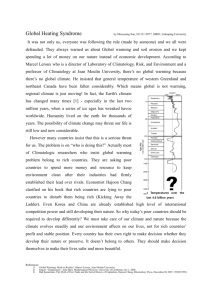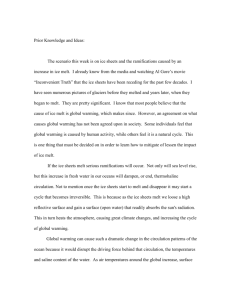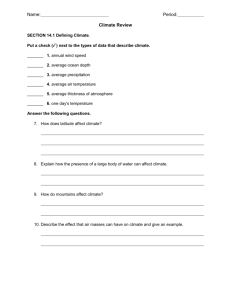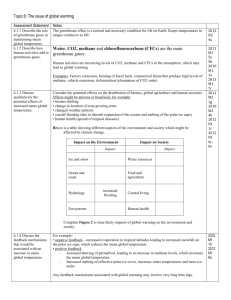Global warming - Agricultural Policy Analysis Center
advertisement
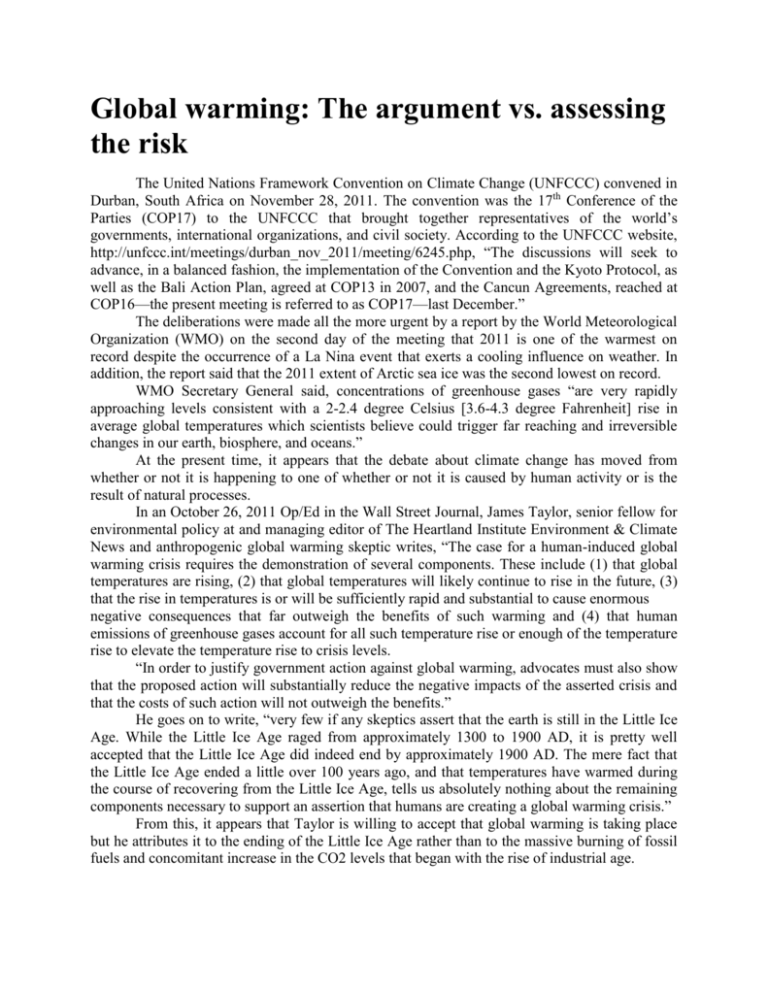
Global warming: The argument vs. assessing the risk The United Nations Framework Convention on Climate Change (UNFCCC) convened in Durban, South Africa on November 28, 2011. The convention was the 17th Conference of the Parties (COP17) to the UNFCCC that brought together representatives of the world’s governments, international organizations, and civil society. According to the UNFCCC website, http://unfccc.int/meetings/durban_nov_2011/meeting/6245.php, “The discussions will seek to advance, in a balanced fashion, the implementation of the Convention and the Kyoto Protocol, as well as the Bali Action Plan, agreed at COP13 in 2007, and the Cancun Agreements, reached at COP16—the present meeting is referred to as COP17—last December.” The deliberations were made all the more urgent by a report by the World Meteorological Organization (WMO) on the second day of the meeting that 2011 is one of the warmest on record despite the occurrence of a La Nina event that exerts a cooling influence on weather. In addition, the report said that the 2011 extent of Arctic sea ice was the second lowest on record. WMO Secretary General said, concentrations of greenhouse gases “are very rapidly approaching levels consistent with a 2-2.4 degree Celsius [3.6-4.3 degree Fahrenheit] rise in average global temperatures which scientists believe could trigger far reaching and irreversible changes in our earth, biosphere, and oceans.” At the present time, it appears that the debate about climate change has moved from whether or not it is happening to one of whether or not it is caused by human activity or is the result of natural processes. In an October 26, 2011 Op/Ed in the Wall Street Journal, James Taylor, senior fellow for environmental policy at and managing editor of The Heartland Institute Environment & Climate News and anthropogenic global warming skeptic writes, “The case for a human-induced global warming crisis requires the demonstration of several components. These include (1) that global temperatures are rising, (2) that global temperatures will likely continue to rise in the future, (3) that the rise in temperatures is or will be sufficiently rapid and substantial to cause enormous negative consequences that far outweigh the benefits of such warming and (4) that human emissions of greenhouse gases account for all such temperature rise or enough of the temperature rise to elevate the temperature rise to crisis levels. “In order to justify government action against global warming, advocates must also show that the proposed action will substantially reduce the negative impacts of the asserted crisis and that the costs of such action will not outweigh the benefits.” He goes on to write, “very few if any skeptics assert that the earth is still in the Little Ice Age. While the Little Ice Age raged from approximately 1300 to 1900 AD, it is pretty well accepted that the Little Ice Age did indeed end by approximately 1900 AD. The mere fact that the Little Ice Age ended a little over 100 years ago, and that temperatures have warmed during the course of recovering from the Little Ice Age, tells us absolutely nothing about the remaining components necessary to support an assertion that humans are creating a global warming crisis.” From this, it appears that Taylor is willing to accept that global warming is taking place but he attributes it to the ending of the Little Ice Age rather than to the massive burning of fossil fuels and concomitant increase in the CO2 levels that began with the rise of industrial age. The purpose of this column is not to argue about the science, after all we are not climatologists. Rather our concern is what should farmers make of all of this and what impact might it have on their operations. Without regard to its cause, continued global warming could have a significant impact on agricultural production and where certain crops are grown. With climate change we are told that we will see an increase in extreme weather events—longer droughts in traditionally droughty areas, an increase in heavy rain events, and a shifting of crop zones northward so that Canada and Russia might produce more corn and soybeans, while US and EU farmers will have to shift to warm season varieties and warm season crops. For instance, cotton production could move northward. This brings us to a set of questions that we often ask and is not in Taylor’s list. One, “suppose the WMO is correct and we are experiencing anthropogenic (human caused) climate change and we do nothing, what is the worst thing that can happen?” Two, “suppose we engage in activities to mitigate human caused climate change and it turns out that human activity has nothing to do with the rise in global temperatures and decrease in Arctic sea ice that we are seeing?” Let us look at these one at a time. In the first case, by not reducing carbon emissions in our farming operations and not engaging in farming practices that increase carbon sequestration in our soils we contribute directly to global warming. In addition by turning away from farming practices that increase carbon sequestration—practices that also increase the ability of the soil to resist erosion and increase the absorption of water—we put ourselves at risk of increased erosion during the fewer but heavier rain events that are predicted. In addition, we may be unprepared for the shift in crop mix and the associated infrastructure that would be required. On the other hand, if we reduce our use of fossil fuels and engage in farming practices that sequester carbon in our soils, and it turns out that global warming is the hoax that some claim it to be, what is the worst thing that can happen? We have spent less money on increasingly expensive fossil fuel. We have created a soil that has greater carbon content and an increased ability to hold water and other plant nutrients. Our yields may be down a little, but our costs are lower as well. And the infrastructure that we have built up to handle our present crop mixes still works well. Part of our response to issues where the answers might not be as clear as we would want them to be is to understand that our response needs to be an engagement in risk assessment, looking at the worst case scenarios and determining which set of risks we want to take and how we respond to those risks. At this time, not all farmers agree on the science behind climate change, but all need to engage in a risk assessment exercise and determine what response they are going to make on their farm. To do nothing is to make a choice. Daryll E. Ray holds the Blasingame Chair of Excellence in Agricultural Policy, Institute of Agriculture, University of Tennessee, and is the Director of UT’s Agricultural Policy Analysis Center (APAC). Harwood D. Schaffer is a Research Assistant Professor at APAC. (865) 9747407; Fax: (865) 974-7298; dray@utk.edu and hdschaffer@utk.edu; http://www.agpolicy.org. Reproduction Permission Granted with: 1) Full attribution to Daryll E. Ray and Harwood D. Schaffer, Agricultural Policy Analysis Center, University of Tennessee, Knoxville, TN; 2) An email sent to hdschaffer@utk.edu indicating how often you intend on running the column and your total circulation. Also, please send one copy of the first issue with the column in it to Harwood Schaffer, Agricultural Policy Analysis Center, 309 Morgan Hall, Knoxville, TN 37996-4519
